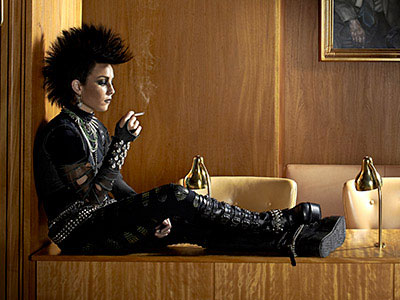The Girl Who Kicked the Hornet's Nest
by George Sax

Dark Scandinavian schemes and scandals
The Girl Who Kicked the Hornet's Nest
It may offer some relief to Americans dismayed at last week’s rightward lurch by this country’s electorate to reflect on Sweden, or at least the country depicted by the late Swedish author Stieg Larsson, whose trilogy of internationally bestselling crime novels, and the three movies based on them, including the latest, The Girl Who Kicked the Hornet’s Nest, give us a disquieting picture of Swedish society. Sure, those Swedes may enjoy universal healthcare (and better health than ours), cleaner air, lower poverty rates, greater access to childcare, and much better high school graduation rates than America’s, but are they happy? Not in Larsson’s Sweden, they aren’t.
Amid their social-democratic demi-paradise, the novelist shows us lurking, dangerous men capable of monstrous deeds, frequently against women (a favorite theme of the anti-misogynist Larsson), often protected by shadowy individuals wielding state power. Indeed, much of the narrative thrust of the novels and the films is propelled by the brutal victimization of the title’s “Girl,” Lisbeth Salander (Noomi Rapace), who has been serially beaten, raped, and incarcerated illegally in an institution for the criminally insane, where she’s placed in restraints. And that’s just for starters.
The relentless abuse and persecution of Salander has been perpetrated by professional pillars of Swedish society—lawyers, psychiatrists, social workers—and done with the approval and encouragement of government officials. These crimes and conspiracies are undertaken to protect official secrets and misconduct, including the plotting against Salander. Starting with the first, and continuing through the next two movies, something is very rotten in Larsson’s state of Sweden.
Repeated flashbacks hint at and eventually explain Salander’s victimization. Her gruesome attack against her Russian-born father, committed when she was only 13, is at the root of her troubles. Her evil father, Alexander Zalachenko, appears only briefly in Hornet’s Nest, but his relationship to powerful individuals is at the core of the series’ often violent and detail-laden narrative.
A large part of the book and movies’ broad appeal is Salander’s resolute, kick-ass self-empowerment and eerie self-possession. She may be a victim but she’s no vulnerable fugitive; she’s a pierced, spike-haired, lithe, leather-clad figure, slim as a wraith but a fearsome martial arts combatant. (Deceptively slight, she surprises a federal prosecutor who, meeting her for the first time, remarks to a colleague that she resembles a very young girl.) After her years of mistreatment, Salander is also an unemotive, rather anomic isolate who is hard put to connect with others.
At least in her film incarnation, she’s rather like a Japanese manga comic character, and Rapace’s success in getting us to at least temporarily buy into this pulp-literature portrait, working as she does with minimalist material, is not a negligible accomplishment.
Unfortunately, Hornet’s Nest has Salander out of commission for the bulk of the movie. Until near its end, she’s in durance very vile, either in a hospital room, a jail cell, or a courtroom. The brunt of the action falls on her friend and sometime partner-in-detection, crusading journalist Mikael Blomkvist (Michael Nyquist), and the movie involves his attempts to clear Salander of a bogus attempted murder charge, as well as dodge attempts against his own reputation and safety.
Director Daniel Alfredson, who also did the second film, The Girl Who Played With Fire, has impressive craft skills. He employs compelling shot compositions and striking use of lighting, but despite some tense scenes, the whole affair increasingly comes off a formulaic wrapup. Viewers who don’t know the first two will probably find this one largely incomprehensible, and even initiates may think it’s a little tedious.
The best of the three is the first, The Girl With the Dragoon Tattoo, and it has the least to do with the core conspiracy. And none of them explains what’s eating those unhappy Swedes.
Watch the trailer for The Girl Who Kicked the Hornet's Nest
blog comments powered by Disqus
|
Issue Navigation> Issue Index > v9n45 (week of Thursday, November 11) > The Girl Who Kicked the Hornet's Nest This Week's Issue • Artvoice Daily • Artvoice TV • Events Calendar • Classifieds |









 Current Issue
Current Issue